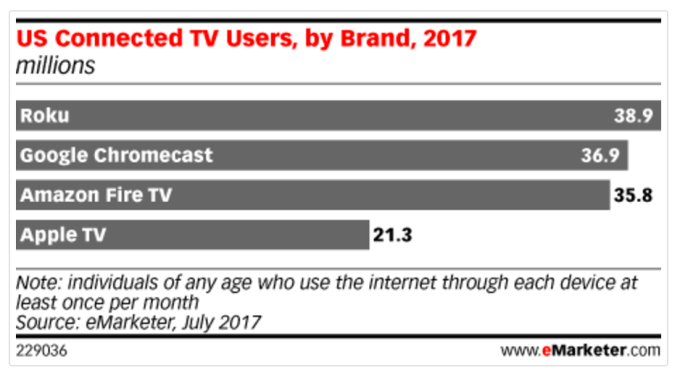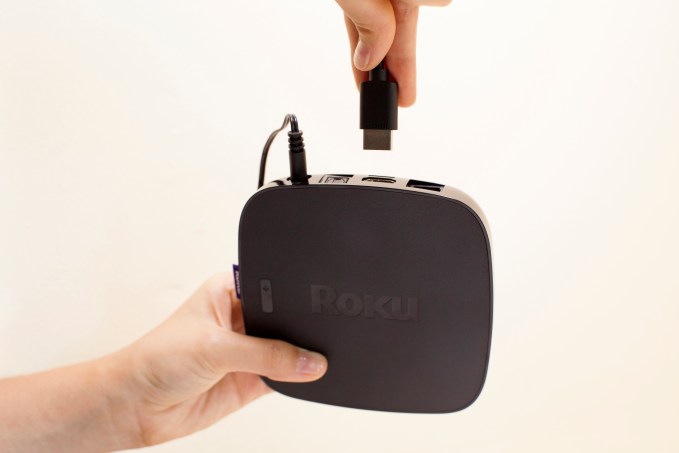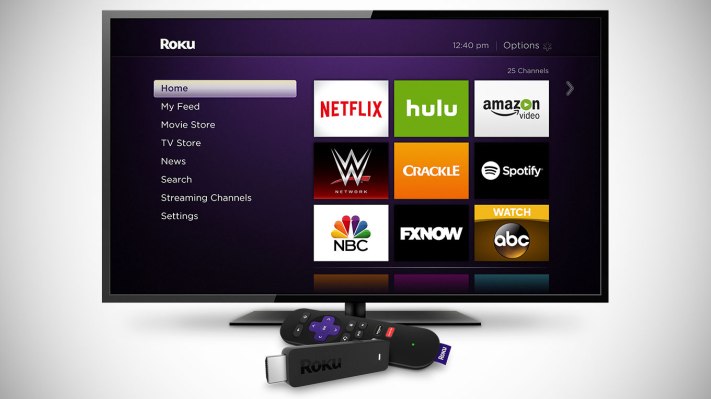Roku may be the most-used connected TV device this year, edging out Chromecast, Fire TV and Apple TV, according to a new 2017 forecast from eMarketer released this morning. The firm estimates that 38.9 million U.S. users will use a Roku device at least once per month in 2017, up 19.3 percent from last year. This would lead to Roku capturing 23.1 percent of all connected TV users, in terms of market share.
eMarketer’s estimates for Roku, however, are much higher than Roku’s own recently released statistics. Earlier this month, Roku said it reached a milestone of 15 million monthly active user accounts across its platform, which encompasses its range of streaming media players and Roku TVs.
The big discrepancy between eMarketer’s numbers and Roku’s own has to do with how “monthly actives” are being counted, we understand, after checking with various sources.
Roku’s active user accounts are those who have streamed within the last 30 days. eMarketer, on the other hand, counts individual users of streaming devices who used the internet through the device at least once per month. Because Roku devices don’t have user profiles where each person get their own Roku account, the devices will have multiple users associated with a single Roku account in many U.S. households.
eMarketer’s forecast puts Roku slightly ahead of Chromecast in the U.S., which will have 36.9 million users this year, or 22.0 percent of connected TV users. Amazon Fire TV will have 35.8 million users in 2017, or 21.3 percent of connected TV users.
Apple TV lags much further behind, with 21.3 million users this year, or just 12.7 percent of U.S. connected TV users.

Roku is coming out ahead because it’s a neutral player in a market where competitors are pushing their own hardware, software, content marketplaces, and/or streaming services.
“As the only major market participant not affiliated with a content or TV device platform, Roku has used its neutrality to strike deals with a wide range of partners, including smart TV makers, over-the-top service providers and social media companies,” said Paul Verna, principal video analyst at eMarketer.
“That expansive strategy, combined with the company’s broad selection of connectivity devices at various price points, has put Roku at the head of the pack,” he added.
It’s hard not to agree. On Roku, you don’t run into issues like not being able to watch your Amazon videos because Apple and Amazon are in a fight.
While those two rivals finally came to an agreement which will see Amazon Video’s app hitting Apple’s TV platform this year, Amazon users for several years could only watch their videos via AirPlay on Apple TV.
Verna also points to the lack of the Amazon Video app as one of the things impacting Apple TV’s market share, along with its lack of a “compelling content offering,” and a much higher price bracket.
Apple’s hardware starts at $150, while Google, Amazon and Roku all offer streaming sticks priced under $40, the report noted.

Roku’s neutrality benefits consumers who don’t want to be tied into one hardware or software ecosystem.
The company doesn’t have its own streaming service to push, like Amazon, whose Prime Video content and recommendations dominate its Fire TV user interface. Nor does it have a content marketplace where users rent or buy movies or shows, like Amazon, Apple and Google today do.
Instead, Roku users customize their device with the services they want to access – whether that’s Google Play Movies & TV, Amazon, Netflix, Hulu, or any other of the now 5,000 channels that can be added to Roku.
As for Apple’s position in the market, eMarketer is not predicting that it will be able to reverse the trend of trailing its rivals anytime soon. The firm forecasts that competitors will add between 20 million to 30 million users by the end of 2021, but Apple TV will add less than 4 million.
This estimate, however, should be taken with the proverbial grain of salt. Apple could introduce new hardware or a more robust streaming service before then, as it’s been rumored – and this, in turn, could drive further adoption.
While Apple stopped trying to sell a “skinny bundle” of TV channels, it has reportedly been working on a premium bundle add-on, which could also entice users. It also has started rolling out original content for Apple Music. Though Apple Music’s originals don’t offer anything super compelling for the time being (unless you actually liked “Planet of the Apps”), it could be something that Apple chooses to expand over time.
One other notable estimate from eMarketer’s report is that it downwardly revised its forecast of total connected TV viewers, due to increased sales of smart TVs. This will impact those in the market for a third-party connectivity device, Verna said.
In 2017, 168.1 million people in the US will use an internet-connected TV, up 10.1 percent over last year. Smart TVs are the largest subgroup in that category.
